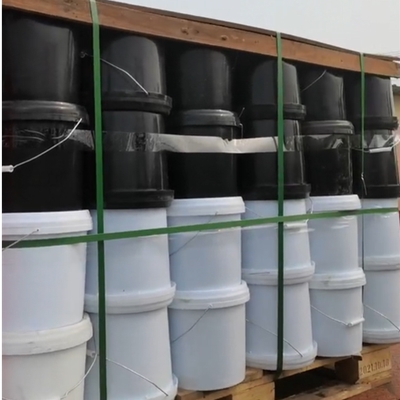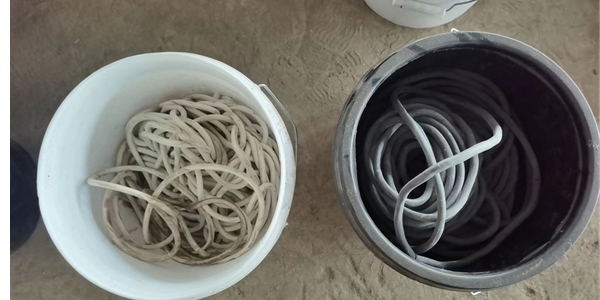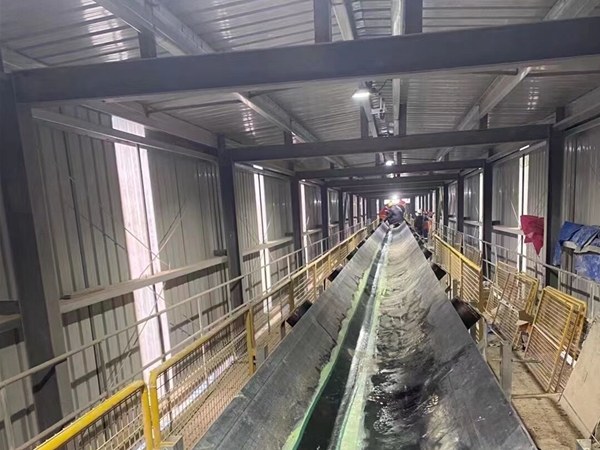Conveying systems are the core of most quarries and mines. Mining companies do their best to improve operational efficiency and reduce costs. When seeking to optimize productivity, conveying systems are an excellent primary checkpoint. In any conveying system, an important key area is splicing. In most applications, there are two preferred splicing methods: mechanical splicing, which connects the belt ends through metal hinges or plates; and vulcanized joints, which are heated and/or chemically substance is attached to the end of the belt.
When deciding which splicing method to use, it is important to understand the advantages and disadvantages of each method. What environmental factors may affect splicing? Are employees facing time constraints? What are the costs associated with long conveyor downtime? Among the many questions to be asked about mechanical fastening and vulcanization, these are some of the key ones.
1. Process of Vulcanization
Vulcanization is a complex process that, if performed correctly by an expert, can provide a smooth joint and minimize the risk of breaks, tears and other harmful wear to the belt. There are several types of vulcanized joints, including stepped joints, finger joints and overlapping joints. There are two types of vulcanization processes: cold and hot. Each process requires unique tools and expertise in rubber bonding processes.
Whether it is hot vulcanization or cold vulcanization, the belt must be disassembled, and each belt end must be prepared according to the specific belt connection recommendations. Proper belt preparation is crucial to ensure that the completed splice will maintain its published tensile rating.
With thermal vulcanization, the joint is heated and cured under pressure with a vulcanizer. This process takes several hours. If the belt is re-tensioned and used before engagement and complete cooling, the engagement will be ineffective and may be completely separated, causing additional downtime.
Cold vulcanization does not use a vulcanizer but uses an adhesive to cause a chemical reaction to splice the ends of the two belts together.
During vulcanization, several factors must be considered to ensure high-quality joints. First, the vulcanization splicing must be carried out by an expert who is skilled and trained in this process, who has a comprehensive understanding of solvents, bonding materials and other covering and filling materials.
Secondly, this process requires a specific temperature, compression and equipment residence time, in addition to a work area with almost no moisture.
Third, some types of belts may not allow vulcanization. Considering that vulcanization may not always be uniform, vulcanizing a worn belt may not be a good choice when it is old, dirty, or unevenly worn.
Depending on the working conditions, the vulcanization splicing of the 600mm wide tape may take 6 to 11 hours. A wider belt may take longer. Since vulcanization usually requires specialized vulcanizing personnel and equipment to arrive on site, the operation may be suspended for half a day or longer.
In summary, vulcanized splicing can be used on the following occasions:
- A conveyor belt is clean and free of pollutants such as oil, sand, and fine materials
- A conveyor belt is compatible with the selected adhesive
- The belt is new or not excessively worn
- The program is executed by a trusted and certified vulcanizer
- The working environment is at the optimal temperature and humidity level
- The area that needs to be spliced is easy to enter, and the working space is also large
- Sufficient downtime to allow correct installation of vulcanized joints.
2. Mechanical fasteners
Mechanical splicing and installation are quick and simple. Depending on the width and thickness of the belt, most mechanical joints can be completed in less than an hour and installed by insiders using portable, easy-to-use installation tools.
If an accidental engagement is required, there is no need to wait for professional assistance. In addition, mechanical joints can be performed in a restricted environment that does not consider space, temperature, humidity, or contaminants.
Mechanical splicing can also reduce tape waste and visibility of splicing conditions, both of which can significantly reduce costs. Since vulcanized joints usually consume 2-3m of belt length, if multiple joints are needed over time, the conveyor may not have enough “coiling”.
In addition, since the mechanical joints are visible, wear and degradation are obvious and can be dealt with before a complete belt failure. In contrast, vulcanized joints usually deteriorate from the inside out due to poor adhesion. The first signs of wear appeared too late to take any preventive measures, resulting in a longer downtime.
3. Mechanical splicing
As with vulcanization, there are several types of mechanical fasteners, each of which is manufactured for different belt widths, lengths, thicknesses, speeds, tensions, and belt cleaners.
Identifying the correct fastener is essential to ensure maximum connection life and performance. The mechanical fastener unit can be hinged or solid, and there are many types of connections, such as bolts, rivets, and staples.
For extraction applications, rivet hinge fasteners allow maximum versatility. They combine top and bottom fastener plates, connected by two wide hinge loops at one end. The staggered pattern rivets are used to attach the plates to the belt end. The rivets penetrate the belt without damaging or weakening the carcass of the belt because they slide between the load-bearing carcass fibres. The rivets are installed in a staggered manner to provide maximum tensile strength and evenly distribute the joint tension across the width of the belt.
Regardless of the condition of the belt, mechanical fasteners are a good choice, whether they are new or old, worn belts. As long as the pulley diameter does not exceed 230mm, rivet hinge fasteners can be used on belts with a thickness ranging from 3 to 25 mm.
Concerns about the strength of similar vulcanized joints can also be ignored: rivet hinged fasteners have a long history of use on belts, with mechanical fasteners up to 350kN/m or 2000 pounds per inch wide (PIW).
Since the hinge pin can be easily separated from the hinge fastener by removing the hinge pin, these designs are essential in mining and quarrying applications where the belt must be frequently removed, extended or shortened. In addition, hinge fasteners provide several installation advantages in these applications.
For example, the hinge fastening system allows pre-splicing the various parts of the belt, and only the hinge pin needs to be inserted at the worksite. In addition, if different thicknesses of belts must be connected, hinge fasteners can usually meet this need, allowing two different fasteners half to be connected by a hinge pin, which can be accepted by both parties. In addition, mechanical fasteners can be installed quickly and easily by in-house maintenance personnel on-site, usually within 60 minutes.
The mechanical joint installation tool is easy to transport to the site and provides a variety of installation methods for joint installers. According to the power supply available on site, the mechanically connected rivet hinge joint can be installed with a few basic installation tools and hammers, or it can be installed with improved installation tools, and choose electric or pneumatic power.
Mechanical fasteners can also be countersunk during the installation process, so the fastener plate is flush with the belt cover, eliminating interference with the conveyor components such as tightly mounted scrapers and skirts. The countersunk head also strengthens the connection between the fastener and the belt and is closer to the load-bearing skeleton fibre of the belt through the positioning plate. The strength of the belt remains intact, because only part of the top cover material is removed, and the important carcass fabric of the belt is intact.
In addition to virtually eliminating fastener breakage, rivet hinges reduce downtime by giving maintenance personnel more freedom in deciding when to replace joints. Any joint damage or wear is very obvious on the mechanical joints, and the operator can complete a shift, even if a few boards are missing, without worrying about belt failure
4. Vulcanization vs Fastening- some common misconceptions
The method of splicing the belt must be chosen carefully, and there are several common misconceptions about the process.
1) Mechanical fasteners cannot be used for high-tension belts (that is, more than 800piw).
Synthetic belts and improved fastener design make mechanical fasteners compatible with belt tension ratings up to 350kN/m (2000 PIW).
2) With mechanical fasteners, the screening of handling materials is a problem.
In order to prevent leakage and screening, vulcanized belts are ideal. However, considering all factors, mechanical fastening may be better. If the joints are correct, there should be no problems with sieving. The solid plate joint can be screened, if the filler material is used with the hinge fastener, only the minimum screening should be performed.
It is noisy, difficult to clean and scrape with mechanical fasteners, and often damages the belt. If the mechanical joints are properly installed, maintained, and sunk by planning the belt, the belt or belt cleaner should have no noise or damage.
3) All belts can be vulcanized
Old and/or worn fabric waistbands are not suitable for vulcanization because the waistband layer is weak and will become weak when heated. A rubber belt that has been used for decades cannot be vulcanized because over time rubber loses its adhesive properties. Finally, vulcanization requires additional belt length, so small belt removal operations may not have enough belt vulcanization.
4) You can vulcanize at any time, anywhere
Vulcanization is only suitable for clean, dry and relatively warm conditions. In the case of extreme heat and moisture, nicks and/or bubbles can occur due to chemical residues and excess moisture. These conditions in turn weaken the strength of the joint. In addition, vulcanization is very difficult in places that are not easily accessible.
5) Vulcanization does not mean a lot of downtimes
Vulcanization actually requires a considerable amount of time to stop the belt longer than the mechanical connection will take. A vulcanized joint also depends on the schedule of the vulcanizer, not just the time it takes for these chemicals to cure.
6) Vulcanization will not affect the strength of the belt
Vulcanization actually causes the belt to lose a whole layer of strength-even worse if it is not handled properly. On the other hand, mechanical fastening will not compromise the integrity of the belt.
With the naked eye, it can be checked if the vulcanized joint is ruptured or not. Under normal circumstances, the operator does not even know that there is a problem with the vulcanized joint until it fails-this in a catastrophic event that requires immediate closure of the pipeline.
5. Conclusion
In most bulk material handling applications, damage to conveyor belts and conveyor belt joints will always be an unavoidable fact. Therefore, operators and maintenance personnel should have a comprehensive understanding of the available splicing and repair options, and how each method affects production efficiency and cost-effectiveness.
New designs, materials and processes are making mechanical splicing better, and incorporating mechanical belt fasteners into splicing procedures can provide many benefits for yield and bottom line. In most applications, mechanical joints provide the required flexibility, economy, and speed to minimize material and labour costs, and avoid expensive downtime.



